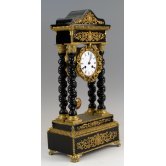No products
Prices are tax excluded
Detailed privacy of the user registry: Here
Legal notice and detailed cookies policy. By continuing to use the site, you accept our use of cookies: Find out more.
137.37
Refurbished
Measures: 55x27x12cm. Machinery: Paris. In operation.
S:XIX. Dial in glazed porcelain. Numbering roman.
With the striking. Finished in patinated bronze.
This product is no longer in stock
Warning: Last items in stock!
Availability date:

Reloj de pórtico para sobremesa Napoleón III
Measures: 55x27x12cm. Machinery: Paris. In operation.
S:XIX. Dial in glazed porcelain. Numbering roman.
With the striking. Finished in patinated bronze.
Recipient :
* Required fields
or Cancel
| State | SOLD |
Desktop clock in operation in the that is a summary of the main features of the so-called Napoleon III: influence of classical Antiquity, the combination of the bronze with the wood in the furniture, the predominance of plant elements, etc
The clock that made up this batch belongs to the type of the so-called “portico”, a category for the table that received this name because of its resemblance with this architectural element.
On a rectangular pedestal supported on four legs, stood another child, both of which are decorated with elements pseudovegetales made in gilded bronze. On this basis, there appear four columns torsas or wreathed in black wood, with their bases and capitals in bronze. Ends the piece another rectangle, a porch and a top of wavy shapes that mark the symmetry of the work to be higher in the central part. The sphere, white, and in romans, hangs from the top. The needles are of type breguet or ancient roman.
Except for the spiral columns, the rest of decorative elements belong to the classical tradition. The so-called Napoleon III was born in France, and is framed in the reign of Charles Louis Napoleon Bonaparte (1808-1873), who was president of the Second French Republic and the ruler of France during the Second Empire (1852-1873). It has in common with the Empire Style the based both in a great extent in Classical Antiquity, from which Napoleon III was an enthusiastic, but in the case of this style, not intended to emulate Imperial Rome. Appreciate the influences of other artistic styles (in the case of this piece, the Baroque by twisted columns; renaissance details in the plant elements, etc.) next to the classical and to the combination of materials that is characteristic of French furniture with Louis XIV and André-Charles Boulle.
No customer reviews for the moment.